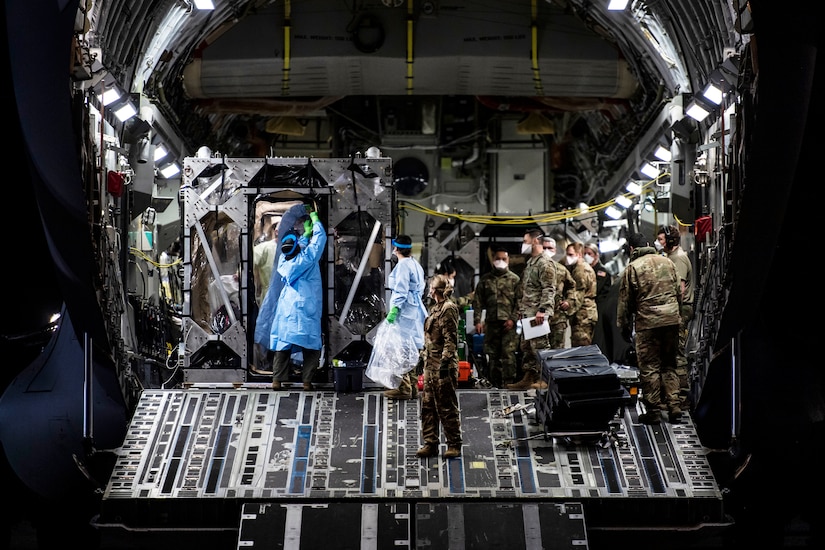April 13, 2020
Air Mobility Command aircrew and medical personnel conducted
the first operational use of the Transport Isolation System to perform an
aeromedical evacuation of three U.S. government contractors who tested positive
for the coronavirus from Afghanistan to Ramstein Air Base, Germany.
Upon arrival April 10 at Ramstein, the patients were
transferred to Landstuhl Regional Medical Center for treatment.
The mission, REACH 725, marked the first operational use of
the TIS since its development during the 2014 Ebola outbreak in West Africa,
and the first movement of COVID-19 positive patients aboard U.S. Air Force
aircraft. The TIS is an infectious disease containment unit designed to
minimize risk to aircrew, medical attendants, and the airframe, while allowing
medical care to be provided to patients in-flight.
REACH 725 featured a full TIS force package, which includes
one C-17 and aircrew carrying two TIS modules and medical support personnel,
consisting of aeromedical evacuation specialists, critical care air transport
team members, infectious diseases doctors and technicians, and TIS operators.
Upon receipt of a warning order from U.S. Transportation
Command on April 8, the 618th Air Operations Center tasked a TIS-trained AMC
aircrew and medical team at Ramstein to prepare to execute the mission within
24 hours. Drawn from multiple specialties and units from across the Air Force,
these airmen were pre-staged with a C-17 from Joint Base Charleston, South
Carolina, and TIS at Ramstein's 86th Airlift Wing in late March in anticipation
of joint force, allied and partner requirements in Europe, Africa and the Middle
East. Since arriving, these airmen have trained to increase proficiency on the
movement of infectious patients via the TIS.
Airmen wearing personal protective gear wait for patient
documentation in the cargo bay of a large transport jet.
"Our unique capabilities, paired with our strategic
locations across the globe, enable us to rapidly help those in need," said
Gen. Jeff Harrigian, commander of U.S. Air Forces in Europe-Air Forces Africa
and NATO Allied Air Command. "Along with our allies and partners, we stand
united against a shared threat and stand ready to help when called."
Hours before the crew stepped to the C-17, Air Force Brig
Gen Jimmy Canlas, 618th Air Operations Center commander, led a teleconference
call in which he provided guidance in line with the recently released AMC
COVID-19 Patient Movement Plan.
"Through the meticulous effort of AMC's planners over
the past few weeks, in coordination with U.S. Transportation Command, we've
produced a detailed plan that guides our crews on how to safely and effectively
move ill patients to a location where they can receive greater care, all while
providing protection for our aircrew, medical personnel and aircraft,"
Canlas said. "Within hours of completing and releasing this plan to the
force, the crew of REACH 725 validated the hard work of these planners by
safely transporting three COVID-19 patients nearly 4,000 miles from Afghanistan
to Landstuhl."
Developed by AMC planners over the past few weeks, the
Patient Movement Plan provides aircrew and support personnel a comprehensive
and detailed process by which to transport patients aboard pressurized,
military aircraft, including patients afflicted with highly contagious diseases
such as COVID-19.
"I'm exceptionally proud of our airmen who executed
this historic [aeromedical evacuation] mission," said Air Force Gen.
Maryanne Miller, AMC commander. "REACH 725 is a great demonstration of
AMC's transition to a warfighting component command, with increased flexibility
and speed enabling our mobility airmen to quickly answer any call for help
during this global campaign to defeat COVID-19. Delivering hope runs deep in
the blood of mobility airmen, and I'm in awe of what they are doing for those
in need."
(Courtesy of Air Mobility Command.)

No comments:
Post a Comment